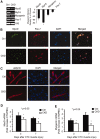Satellite cell dysfunction and impaired IGF-1 signaling cause CKD-induced muscle atrophy
- PMID: 20056750
- PMCID: PMC2831855
- DOI: 10.1681/ASN.2009060571
Satellite cell dysfunction and impaired IGF-1 signaling cause CKD-induced muscle atrophy
Abstract
Muscle wasting in chronic kidney disease (CKD) begins with impaired insulin/IGF-1 signaling, causing abnormal protein metabolism. In certain models of muscle atrophy, reduced satellite cell function contributes to atrophy, but how CKD affects satellite cell function is unknown. Here, we found that isolated satellite cells from mice with CKD had less MyoD, the master switch of satellite cell activation, and suppressed myotube formation compared with control mice. In vivo, CKD delayed the regeneration of injured muscle and decreased MyoD and myogenin expression, suggesting that CKD impairs proliferation and differentiation of satellite cells. In isolated satellite cells from control mice, IGF-1 increased the expression of myogenic genes through an Akt-dependent pathway. CKD impaired Akt phosphorylation in satellite cells after muscle injury. To test whether impaired IGF-1 signaling could be responsible for decreased satellite cell function in CKD, we created an inducible IGF-1 receptor knockout mouse and found impaired satellite cell function and muscle regeneration. In addition, both CKD and IGF-1 receptor knockout mice developed fibrosis in regenerating muscles. Taken together, impaired IGF-1 signaling in CKD not only leads to abnormal protein metabolism in muscle but also impairs satellite cell function and promotes fibrosis in regenerating muscle. These signaling pathways may hold potential therapeutic targets to reduce CKD-related muscle wasting.
Figures





Similar articles
-
Interactions between p-Akt and Smad3 in injured muscles initiate myogenesis or fibrogenesis.Am J Physiol Endocrinol Metab. 2013 Aug 1;305(3):E367-75. doi: 10.1152/ajpendo.00644.2012. Epub 2013 Jun 4. Am J Physiol Endocrinol Metab. 2013. PMID: 23736539 Free PMC article.
-
Formononetin ameliorates muscle atrophy by regulating myostatin-mediated PI3K/Akt/FoxO3a pathway and satellite cell function in chronic kidney disease.J Cell Mol Med. 2021 Feb;25(3):1493-1506. doi: 10.1111/jcmm.16238. Epub 2021 Jan 6. J Cell Mol Med. 2021. PMID: 33405354 Free PMC article.
-
Altered expression of genes regulating skeletal muscle mass in the portacaval anastomosis rat.Am J Physiol Gastrointest Liver Physiol. 2007 Apr;292(4):G1105-13. doi: 10.1152/ajpgi.00529.2006. Epub 2006 Dec 21. Am J Physiol Gastrointest Liver Physiol. 2007. PMID: 17185634
-
Function of the myogenic regulatory factors Myf5, MyoD, Myogenin and MRF4 in skeletal muscle, satellite cells and regenerative myogenesis.Semin Cell Dev Biol. 2017 Dec;72:19-32. doi: 10.1016/j.semcdb.2017.11.011. Epub 2017 Nov 15. Semin Cell Dev Biol. 2017. PMID: 29127046 Review.
-
Muscle wasting from kidney failure-a model for catabolic conditions.Int J Biochem Cell Biol. 2013 Oct;45(10):2230-8. doi: 10.1016/j.biocel.2013.06.027. Epub 2013 Jul 16. Int J Biochem Cell Biol. 2013. PMID: 23872437 Free PMC article. Review.
Cited by
-
The wasting-associated metabolite succinate disrupts myogenesis and impairs skeletal muscle regeneration.JCSM Rapid Commun. 2020 Jul-Dec;3(2):56-69. doi: 10.1002/rco2.14. Epub 2020 Jun 2. JCSM Rapid Commun. 2020. PMID: 32905522 Free PMC article.
-
Satellite cell function, intramuscular inflammation and exercise in chronic kidney disease.Clin Kidney J. 2018 Dec;11(6):810-821. doi: 10.1093/ckj/sfy052. Epub 2018 Jul 30. Clin Kidney J. 2018. PMID: 30524716 Free PMC article.
-
Transcription factor FoxO1, the dominant mediator of muscle wasting in chronic kidney disease, is inhibited by microRNA-486.Kidney Int. 2012 Aug;82(4):401-11. doi: 10.1038/ki.2012.84. Kidney Int. 2012. PMID: 22475820 Free PMC article.
-
An Intronic Enhancer Element Regulates Angiotensin II Type 2 Receptor Expression during Satellite Cell Differentiation, and Its Activity Is Suppressed in Congestive Heart Failure.J Biol Chem. 2016 Dec 2;291(49):25578-25590. doi: 10.1074/jbc.M116.752501. Epub 2016 Oct 18. J Biol Chem. 2016. PMID: 27756842 Free PMC article.
-
Muscle Wasting in Chronic Kidney Disease: Mechanism and Clinical Implications-A Narrative Review.Int J Mol Sci. 2022 May 27;23(11):6047. doi: 10.3390/ijms23116047. Int J Mol Sci. 2022. PMID: 35682722 Free PMC article. Review.
References
Publication types
MeSH terms
Substances
Grants and funding
LinkOut - more resources
Full Text Sources
Other Literature Sources
Medical
Molecular Biology Databases
Miscellaneous

